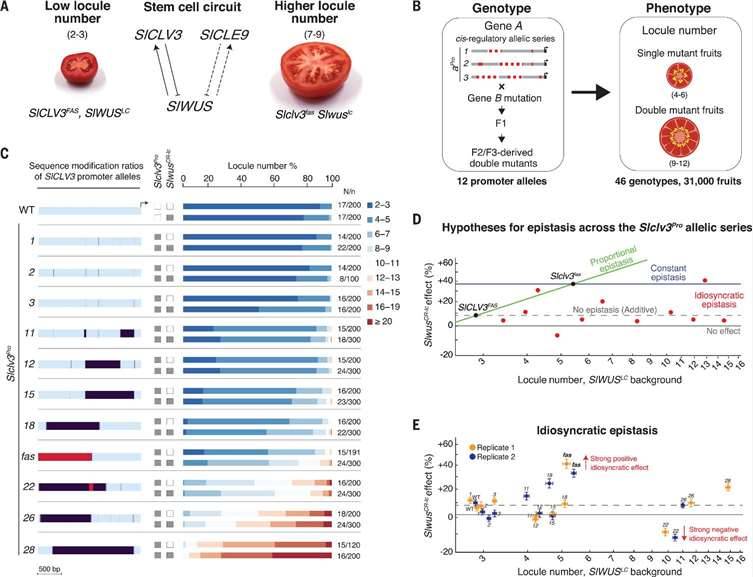Gene epistasis, a fundamental genetic phenomenon, occurs when the expression of a gene mutation is influenced by mutations in one or more other genes. Investigating gene epistasis is of paramount importance in unraveling the intricate interplay among genes. Traditional research strategies involve observing phenotypic changes in study subjects resulting from either natural or induced mutations that lead to functional alterations in the encoded proteins of different genes. These observations provide insights into the epistatic relationships between the functions of distinct genes.
Recent advancements in high-throughput sequencing technology have enabled the comprehensive exploration of the intricate network of epistatic regulation at the genetic level. However, most current studies predominantly focus on protein-level mutations. This approach overlooks the extensive array of cis-regulatory patterns that govern the spatial and temporal expression of genes in the genome. These patterns, in turn, exert a profound influence on the functionality of the proteins they encode. Consequently, gene function is often more affected by their expression profiles.
The present challenge in gene epistasis research lies in the limited availability of data concerning variations in cis-regulatory regions for known interacting genes and the limited reliability of phenotypic data associated with these sites. Consequently, the study of gene epistasis at this level remains underexplored, despite the vital role these variations play in shaping phenotypes.
Context-Dependent Effects of Cis-Regulatory Elements in Tomato Mutants
To begin, the research team employed gene-editing technology to modify the cis-regulatory region of the Slclv3 gene. Through this process, they generated a variety of tomato mutant materials, each with distinct chamber numbers. From this pool, they meticulously selected 12 exemplary samples with stable heritability, collectively referred to as 'Slclv3Pro.' Subsequently, they combined these samples with both the wild type of the Slwus cis-regulatory element region and a mutant material known as 'SlwusCR-lc' in two different combinations. This strategic approach allowed them to create plant materials with diverse combinations of cis-regulatory element variants for both genes.
In their investigation into the synergistic effects of cis-regulatory elements on gene epistasis, the researchers formulated several hypotheses. Firstly, they postulated that the impact of SlwusCR-lc is positively correlated with the strength of the cis-regulatory site in the Slclv3Pro gene. Secondly, they hypothesized that mutations in different regions of the cis-regulatory region have uniform effects on the function of SlwusCR-lc. Lastly, they proposed that the effect of SlwusCR-lc is context-dependent, either enhancing or attenuating, and linked to the genetic background of Slclv3Pro mutant plants.
To rigorously assess these hypotheses, the researchers employed the maximum likelihood method to analyze a suite of nested models. After conducting correlation analyses, they established that the effect of SlwusCR-lc on the Slclv3Pro gene is indeed context-dependent. A striking example of this context dependence is the case of the Slclv3Pro-22 single point mutation, which resulted in a greater number of chambers than observed in SlwusCR-Lc mutant fruits in both the wild type and mutant backgrounds of Slclv3fas. Intriguingly, when the SlwusCR-Lc mutation was introduced on the basis of the Slclv3Pro-22 single-point mutation, it led to a reduction in the number of chambers, signifying a negative regulatory epistatic effect of SlwusCR-Lc on the Slclv3Pro-22 locus. Concurrently, it was observed that Slwuslc exerted a robust positive regulatory epistatic effect on Slclv3fas.
 Idiosyncratic and dose-dependent epistasis drives variation in tomato fruit size. (Aguirre et al., 2023)
Idiosyncratic and dose-dependent epistasis drives variation in tomato fruit size. (Aguirre et al., 2023)
The researchers then delved into the intriguing question of whether the unpredictable up-regulatory effects induced by SlwusCR-lc in conjunction with the Slclv3 cis-regulatory region might be influenced by SlCLE9. Their analysis unveiled a striking correlation: the number of regulatory loci within the Slclv3Pro allele exhibited a directly proportional and synergistic up-regulatory phenotype when coupled with Slcle9. A more in-depth examination of the data model revealed a pattern in the effects of Slcle9, showing a dose-dependent saturation relationship. In essence, the influence of Slcle9 remained minimal until a critical threshold of SlCLV3 disruption was surpassed, beyond which its effects increased, eventually stabilizing as a near-constant enhancement, particularly in the presence of robust Slclv3Pro levels.
The researchers then delved further into the intricacies of epistasis involving higher-dimensional cis-acting element regulation. They explored this phenomenon by creating various combinations of the three Slclv3Pro-Slcle9-Slwuslc mutants. The results of both genotypic and phenotypic correlation analyses shed light on the specific influence of the plant background on bidirectional interactions in the context of these high-dimensional allele combinations (involving three genes).
In this study, they conducted a systematic exploration of the intricate relationship between Slclv3Pro-Slwuslc-Slcle9 at the cis-regulatory level. The research uncovered a noteworthy gene up-regulation phenomenon that proved to be highly dependent on the genetic background. Moreover, it exhibited a dosage effect that directly impacted the number of lumens in tomato fruits, subsequently influencing fruit size. This study not only enhances their comprehension of the complexity of gene epistasis at the cis-regulatory level but also offers valuable insights for future genetic breeding strategies. It encourages a broader consideration of the effects of different genetic backgrounds when designing new allele combinations.
Reference:
- Aguirre, Lyndsey, et al. "Idiosyncratic and dose-dependent epistasis drives variation in tomato fruit size." Science 382.6668 (2023): 315-320.
For research purposes only, not intended for clinical diagnosis, treatment, or individual health assessments.


 Sample Submission Guidelines
Sample Submission Guidelines
 Idiosyncratic and dose-dependent epistasis drives variation in tomato fruit size. (Aguirre et al., 2023)
Idiosyncratic and dose-dependent epistasis drives variation in tomato fruit size. (Aguirre et al., 2023)